|
Greetings from KL!
I know it's the era of social media and bite-sized news where catchy headlines and viral posts rule the world. However, I am going to write this blog post the good-old fashioned way and keep it real. Anyway, can you believe it? It's been nine months since my move to KL. This time round I had overcome the initial quirks of getting to know the city. In fact, this is my first time experiencing Ramadan in KL with its vibrant street bazaar, delicious local food and not to mention the sweltering heat. However, it's not just the weather and the culture that I had gotten accustomed to. I had also survived taking the public transport (which I find highly inconvenient) and am now driving around KL's roads. I now begin to understand when KLites say: "It is better to drive then to take public transport". I used to think how far Pasir Ris was to Jurong until I had to drive from Sepang all the way to Sungai Besi. It felt like an endless journey! So far, I had driven to two speaking engagements wearing my Baju Melayu, explored the nurseries at Sungai Buloh, went to the Ramadan bazaars in Puchong and delivered mattresses as well as groceries as part of my #projectspeakersgiveback CSR programme. Even with the help of the Waze application, I had made many wrong turns along the way as KL's road's and expressways can be quite confusing. I take this as part of my learning experience. Looking back, I still cannot believe that I had survived driving around KL so far. This was good as I needed that spark to write my upcoming book. For months, I have been experiencing the much dreaded writer's block when writing about the train system in KL. The challenge is writing about public transportation and its impact on the property market in a way that will resonate with my readers. I mean, public transport isn't exactly a sexy topic. In comparison, writing Property Buying for Gen Y was effortless as I wrote about the struggles I had faced following a stream of consciousness. Now that I have experienced KL's roads first hand, it has become sort of a catalyst and inspiration for my manuscript. I will put in an equal dose of humour as well. Just wait! On the work front, it has been keeping me very busy. I used to think I work hard in Singapore. However, I work much harder here throwing in almost 12 hours a work a day, travelling for meetings which can sometimes take me to Johor and back home to Singapore. Sometimes, I go up north to Penang. It made my work ethic back in Singapore look really sloppy. I'm not kidding! My diet has also changed drastically. Gone are the fried stuff. I now eat salads and fruits everyday. This wasn't a conscious decision I assure you as I am not particularly bright in the kitchen department. I now even have my own herb garden in my balcony. I have also signed up at a local gym which I try to go to daily when work permits. I have to say though, I feel and look so much more healthier now. On a more serious note, I do notice that bullying in Malaysia has become rather prevalent. I would often read about it in the local newspapers and my Facebook feeds. Bullying can manifest in many forms. They veer from hurtful online comments to physical abuse. Listen, bullying is never ok. Bullies are usually socially awkward and they cower when they are confronted one to one. I say this as I had experienced this personally. I take a strong stance on bullying. If you are on the receiving end of bullying, approach your teachers, managers, friends and family members for help. We are all born differently with unique gifts and talents. Learn to accept differences and respect them. Let's take time to reflect on this during this Ramadan. Speaking of which, I know some of you may be busy making preparations for Hari Raya. However, let us not forget to help the less fortunate as well. You can do your part to ease their burden by visiting old folks home, the orphanage and so on. On my end, I am pleased to say two dormitories housing foreign workers are now well stocked with mattresses and groceries, under our #projectspeakersgivebackproject. Initially, they were in a deplorable state and not fit for human habitation. Many thanks to those of you who had lend your hand and thrown your weight behind this project. As we are heading to the tail end of Ramadan, let's make full use of this blessed month. Remember, goodness begets goodness. May your Ramadan this year be more meaningful. Wishing you a blessed Ramadan.
0 Comments
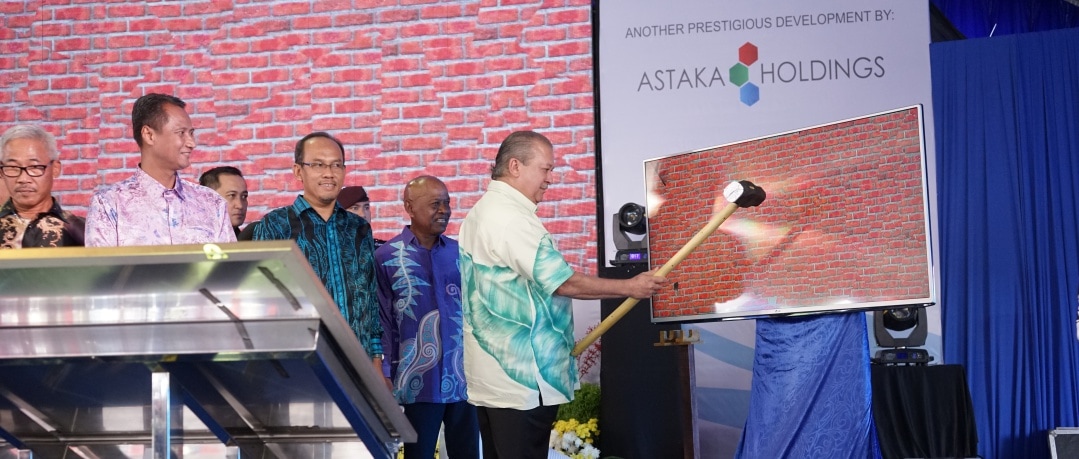 On 21 May, Johor’s Sultan Ibrahim Ibni Sultan Iskandar officiated the grand launch and the opening of sales gallery of Bukit Pelali at Pengerang, a 363-acre project that is Pengerang’s first strata township being developed by Johor-based Astaka Holdings Limited. Iskandar Malaysia, situated within Johor, is the most successful out of the five economic corridors in Malaysia. Photo: Astaka Padu As Iskandar Malaysia surpasses its 10th year as of November 2016, it has continued to defy expectations with these five key achievements By Khalil Adis I recall covering Iskandar Malaysia when it was still very much in its early development stage sometime in 2008 as part of a special feature for Property Report. Hosted by Iskandar Investment Berhad (IIB) and the Iskandar Regional Development Authority (IRDA), I had to wear rubber boots while government officials drove me around in a Land Rover over muddy roads as we cut through dense jungles and oil palm plantations in what is now known as Iskandar Puteri (then called Nusajaya) and Medini. As we passed by what is now known as EduCity and Legoland I was blown away by the massive scale of Iskandar Malaysia’s development. It was, by far, the single largest development that I had covered when reporting on the ground. As I headed back to Singapore to file my story, I called a few of my sources comprising analysts, and markets watchers on what they thought of this special economic zone. “It will fail. Just look at Cyberjaya,” said one. “Another white elephant project,” quipped another. However, that all changed in 2011as bilateral ties between both countries started to warm . That year witnessed Temasek Holdings announcing its investments in two sites in Medini, Iskandar Malaysia, now called Afiniti Medini and Avira. This was followed with another S$3.2 billion worth of investment to build a township development on Danga A2 island in 2013. As bilateral ties began to thaw, so did investors’ confidence. At the peak of the market in 2011, Singaporeans were seen snapping up Iskandar Malaysia properties like hot cakes. With the market now remaining somewhat muted and with concerns of oversupply, market watchers are again writing off Iskandar Malaysia. Whether you like it or not, this “flash in the pan” has indeed come a long way. As Iskandar Malaysia celebrates its tenth year, we look back and list its five major achievements. 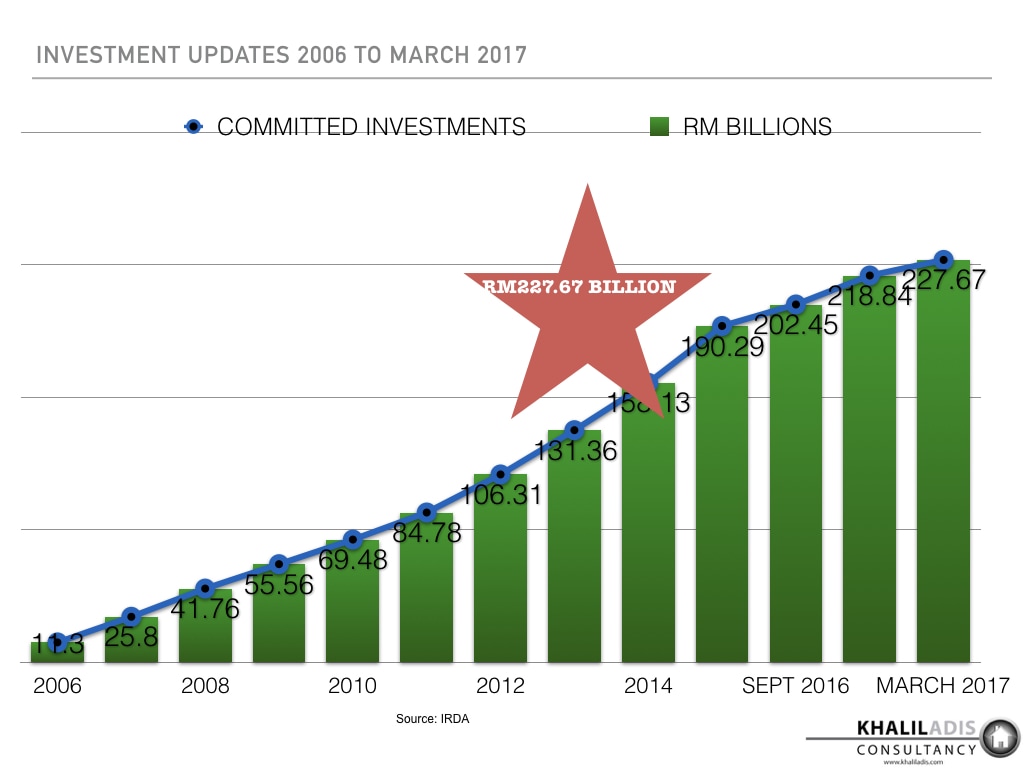 Iskandar Malaysia is the best performing economic corridor out of the five in Malaysia with a total cumulative investment of RM227.67 billion as of 31 March 2017. Graphics: Khalil Adis Consultancy Iskandar Malaysia is the best performing economic corridor out of the five in Malaysia with a total cumulative investment of RM227.67 billion as of 31 March 2017. Graphics: Khalil Adis Consultancy #1 RM227.67 billion in total cumulative committed investment as of 31 March 2017 Not bad. Not bad at all considering the federal had initially invested RM5.8 billion while the manufacturing sector contributed some RM5.5 billion during its initial phase in 2006. Since then, investment volumes have grown by leaps and bounds to reach RM227.67 billion as of 31 March 2017. #2 Return of investment (ROI) of 3,825.34% Now, let’s work on the ROI. With an initial investment from the federal government at RM5.8 billion in 2006 and a total cumulative committed investment of RM227.67 billion as of 31 March 2017 over a span of some 11.45 years, this works out to an investment gain of RM221.87 with an ROI of whopping 3,825.34 per cent! In terms of annualised ROI, this works out to 37.79 per cent. This pales in comparison to the paltry 1.0 per cent interest you get when you put your money in your Singapore bank account. #3 The Chinese are coming in a big way with investments of RM24.61 billion Bye-bye Singapore, hello China! Our tiny city-state no longer holds dominance as the single largest foreign investor in Iskandar Malaysia. In fact, for the past three years or so, China has been coming in droves and snapping up land parcels from Tanjung Pelepas all the way to Tebrau. The good - state government coffers stand to benefit which will have an indirect impact on Johoreans. The bad - concerns on the sustainability and the possibility of inducing price volatility in the property market once these mammoth projects are completed. #4 61% of Iskandar Malaysia’s investments are by the domestic market While some analysts have expressed concerns on the wave of Chinese investments and their potential repercussions, Iskandar Malaysia is still very much driven by domestic investments. Of the RM227.67 billion in total cumulative committed investment as of 31 March 2017, 61 per cent were driven by the domestic investments. This means, even if a foreign investor were to pull out (as in the case of Dubai’s Mubadala) or during a global economic crisis, Iskandar Malaysia can still hold out on its own due to its sheer domestic investment market size. #5 56% investments worth RM138.61 billion have been realised as of 31 March 2017
Enjoy exploring LEGOLAND MALAYSIA or dining by the waterfront at Puteri Harbour? Perhaps some of you have even used your CPF Medisave for your medical treatment at Gleneagles Hospital Medini. Well, these completed projects that you see right now are just the tip of the iceberg. There’s still the remaining 44 per cent that has yet to come on-stream such as Motorsports City, Gerbang Nusajaya and of course the high-speed rail station. Once completed, all these will create around 257,100 additional jobs by 2030 in Iskandar Puteri, according to DTZ Research. The key takeaway when investing in Iskandar Malaysia is this - you must be in for the long-haul in order to reap fully from your investment. It’s definitely not a market for those hoping to make a quick buck or for the cash-strapped. |
Khalil AdisAn independent analysis from yours truly Archives
July 2023
Categories
All
|
100 Peck Seah Street
|
|

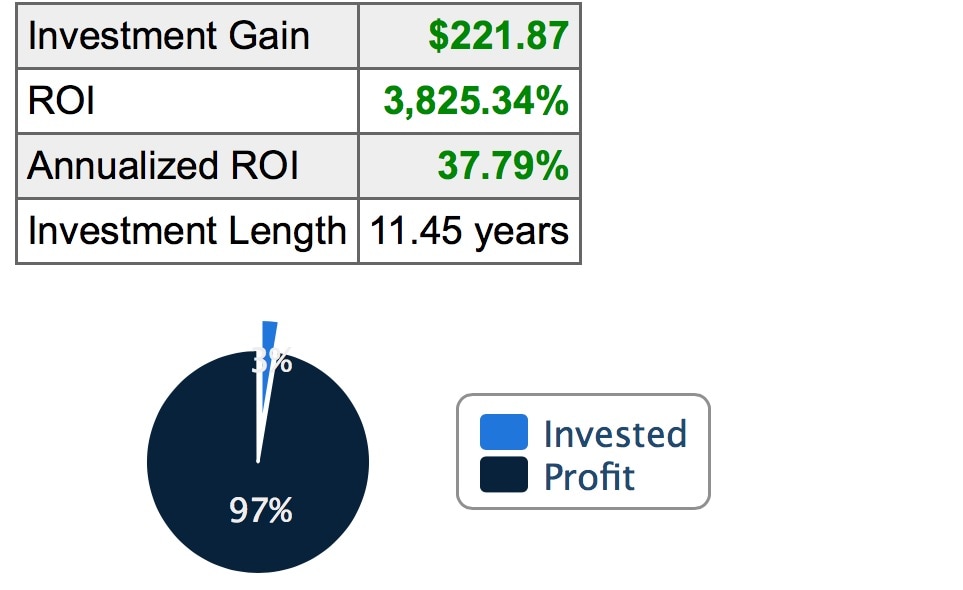
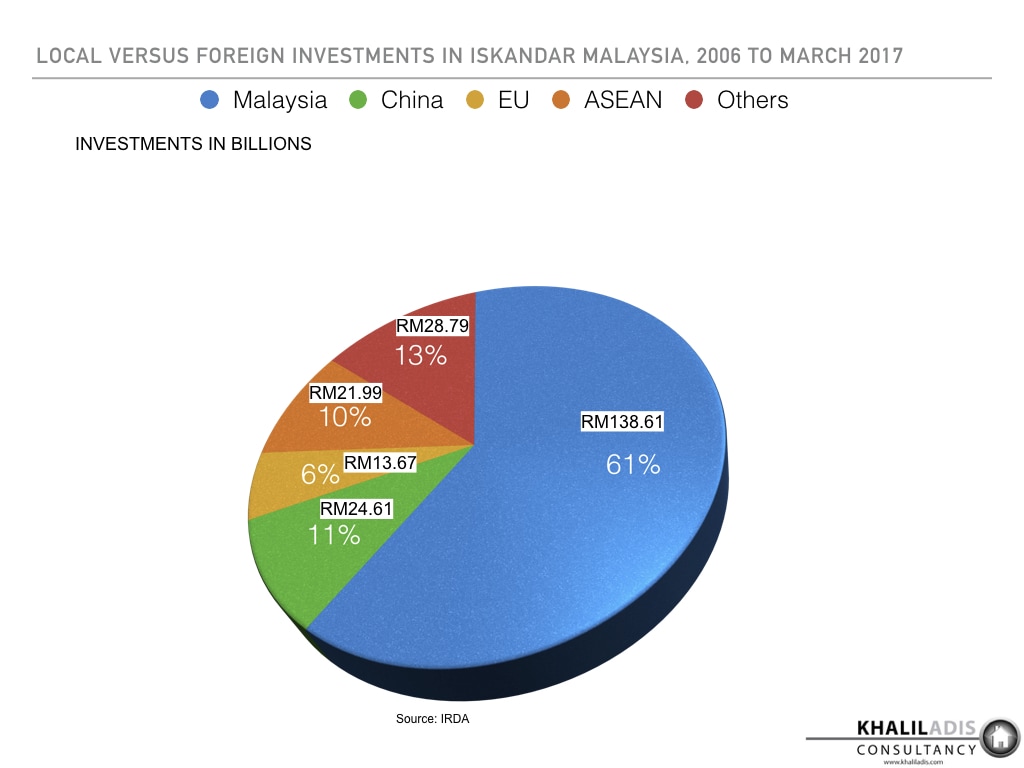
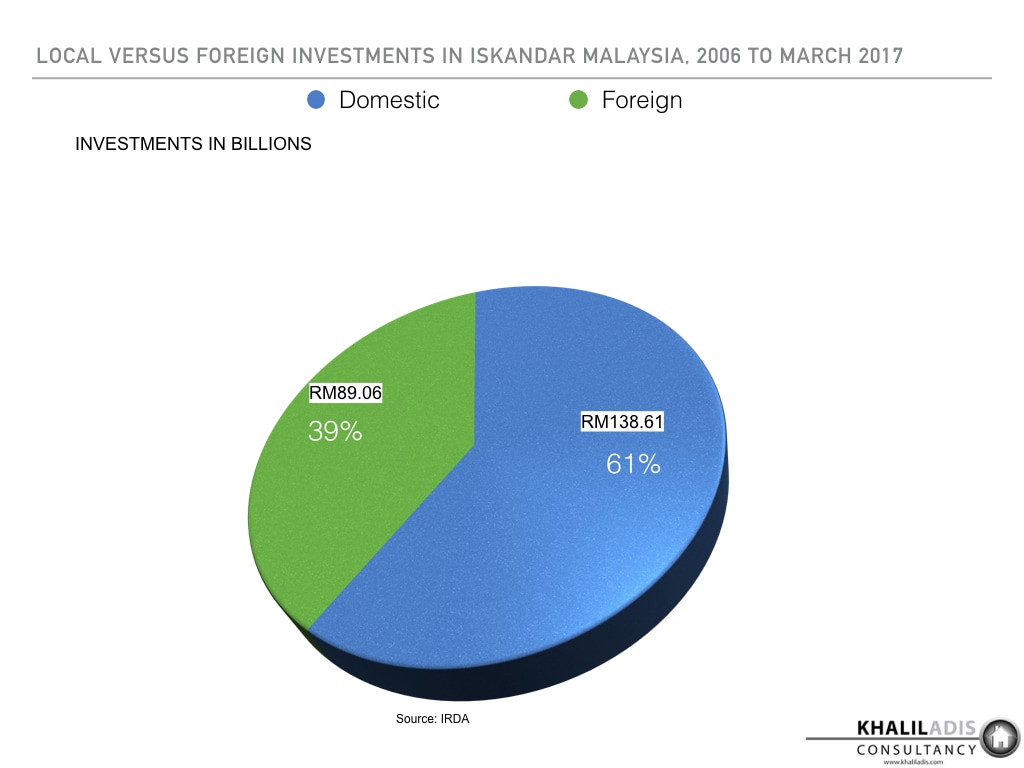
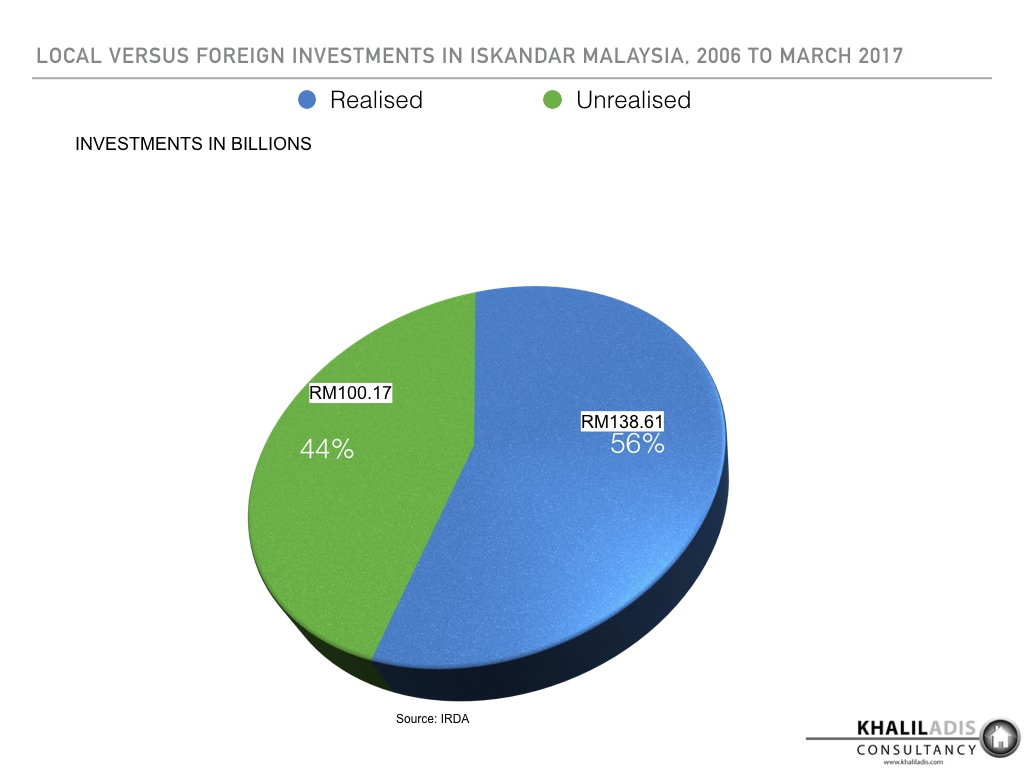
 RSS Feed
RSS Feed
